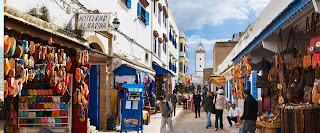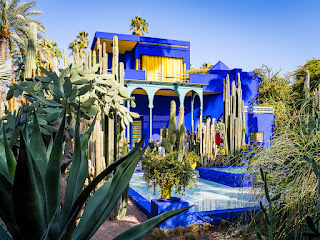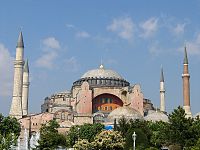There are many world heritage sites in Morocco: the archaeological site of Volulili, the palace of Ait Ben Haddou, Mazagane (New), the ancient city of Essaouira, the ancient city of Fez, the ancient city of Marrakech, the ancient city of Tetouan. , the historic city of Meknes, the cultural space of Jemaa el-Fna square, the city of Tangier and the city of Tan-Tan.
An overview of the Moroccan heritage in ancient cities
Volubilis : was the capital of the ancient Kingdom of Mauritania. It was founded in the 3rd century BC and the Roman Empire made it an important outpost, endowing it with magnificent buildings and monuments. It later became, for a short time, the capital of Idris I, founder of the Idrisid state, and he is buried not far south-east of Volubilis. It is now a partially discovered archaeological site in the northern city of Meknes in northern Morocco.
Ait Ben Haddou : Palace is a group of traditional buildings located in the Ouarzazate region. It was built of clay and surrounded by a defensive wall reinforced with towers. It is characterized by simplicity and durability in its description. This palace, with its distinguished architecture, is considered a model of traditional housing in southern Morocco.
Ait Ben Haddou Palace is included in the list of UNESCO World Heritage Sites.
El Jadida : is a coastal Moroccan city and the capital of El Jadida Province. It is the largest metropolis in the Doukkala region, and one of the two most important centers of the canceled Doukkala-Abda region before the region was annexed in 1436 AH to the Casablanca-Settat region. The population of the municipality of El Jadida in the year 1435 was about two hundred thousand people. The Burghiz (they are Portugal) established one of their most important colonies in Morocco and the last of all.
Essaouira : is a Moroccan city overlooking the Atlantic Ocean and located approximately the same distance from Marrakesh to the west and Agadir to the north, i.e. approximately 175 km. It was built by Sultan Muhammad bin Abdullah Al-Alawi in the year 1178. It is the capital of the province that bears its name and belongs to the Marrakesh-Safi region. The population of the municipality of Souira in 1435 was about eighty thousand people (77,966). Souira is one of the most important fishing ports in Morocco, especially for traditional fishing, and it is both a national and international tourist destination
Since the first decade of the twenty-first century, the government began to encourage investment in the tourism sector, and this was evident in preparing the appropriate infrastructure, including traditional hotels (riads) or modern hotels (classified hotels) and restaurants, and focusing on aspects of attracting tourists (marine sports). Essaouira also Due to its geographical location located between two tourist areas in the tourism sector in Morocco (Agadir and Marrakesh), it has assumed a tourist status due to its moderate climate compared to the rest of the cities, especially the city of Marrakesh, the eastern neighbor where the heat is intense during the summer.
Fez : is the second largest city in Morocco after Casablanca, with a population of 1,112,072 people, according to the 2014 census, and more than two million currently, and the largest city in the Fez-Meknes region. The city of Fez was founded in 182 AH/January 4, 789 (1234 years ago), by Idris II, who He made it the capital of the Idrisid state in Morocco, where in 2008 the city celebrated its 1,200th birthday. Fez is divided into 3 sections: Fez El Bali, which is the old city built in the 8th century AD, Fez El Jadid, which was built in the thirteenth century AD, and the modern city, which was built during the French colonial period.
Thanks to its historical and tourist status, Fez has become one of the cities that is constantly present in the rankings of the best tourist cities to visit, according to international sites specialized in tourism and travel
The most prominent landmarks of the city of Fez
Gates of the city of Fez
Al-Qarawiyyin Mosque
Marrakesh : also called the Red City and the Capital of Palms, is the third largest city in the Kingdom of Morocco in terms of population. It is the capital of the Marrakesh-Safi region
Thanks to its historical and tourist status, the Red City has become one of the cities that is permanently present in the rankings of the best tourist cities to visit according to international sites specialized in tourism and travel.
Jemaa El Fna: Jemaa El Fna Square is considered the most well-known and famous square in Africa and is the center of the city’s activity and commerce
Markets: Marrakesh has the largest traditional market in Morocco and the city's image is closely linked to its markets. Paul Sullivan calls Marrakesh's souks a major shopping attraction in the city
Walls and Gates: Marrakesh's walls, which extend 19 kilometers (12 mi) around the city, were built by the Almoravids in the 12th century as protective fortifications. The walls are made of red-orange clay and a distinctive chalk, giving the city its nickname of the “Red City”; It reaches 19 feet (5.8 m) in height and has 20 gates and 200 towers along its length
Gardens and parks: The establishment of Al-Manara Gardens dates back to the Almohad era, which was a training facility for soldiers to swim, and they decorated it with olive trees at the beginning of the 12th century.
The Majorelle Gardens are located in the city of Marrakesh in Gueliz. It is called Majorelle after the name of its builder, the French painter Jacques Majorelle, who founded it in 1924. In the year 1937, the French painter painted the garden buildings a bright blue color, which surprised the residents of the Red City, where the name Blue was given.
Agdal Gardens or Agdal Groves is a natural park on the outskirts of Marrakesh, Morocco. The visitor can find hundreds of olive, orange, apricot and other fruit trees. These gardens are considered a special place to enjoy tranquility and relaxation, as they are far from the noise and a real haven for those fleeing the noise of the city
Palaces: Badi Palace
Al-Badi Palace is considered one of the achievements of the Saadi King Ahmed Al-Mansur Al-Dhahabi in the year 1578 AD. Its construction coincided with Morocco’s victory over the Portuguese army in the Battle of Wadi Al-Makhzen.
Bahia Palace
The Bahia Palace landmark is located in the center of the old city of the Marrakesh Municipality. The Bahia Palace landmark was built in the nineteenth century at the entrance to the ancient city of Marrakesh by one of the most famous ministers of Sultan Moulay Hassan, known as Bahamad. Due to its vastness and large size, the work on it took a long time until his son completed its construction later
Almoravid dome
Almoravid Dome in El Badi Palace.
Al-Shalhad is the only mountain in Marrakesh that highlights the beauty of Almoravid architecture. The Almoravid Dome is located on the southern side of Ben Youssef Square in the Old City. Excavations conducted in the heart of the city, starting in 1948 AD, revealed one of the rare remains of Almoravid religious architecture in Marrakesh.
Koutoubia Mosque
The Koutoubia Mosque is located in the middle of the city of Marrakesh, near Jemaa El Fna Square. The name of the mosque is derived from “Al-Kutbiyyin,” which is the name of a book market that is believed to have been close to the mosques.
The construction of the first Koutoubia Mosque was ordered by Caliph Abd al-Mu’min ibn Ali al-Koumi in the year 1147 AD on the ruins of the Almoravid Al-Hajar Palace, whose buildings and architectural components were revealed by archaeological excavations.

_(30765760583)_(cropped_to_focus_on_old_town)%20(1).jpg)





































